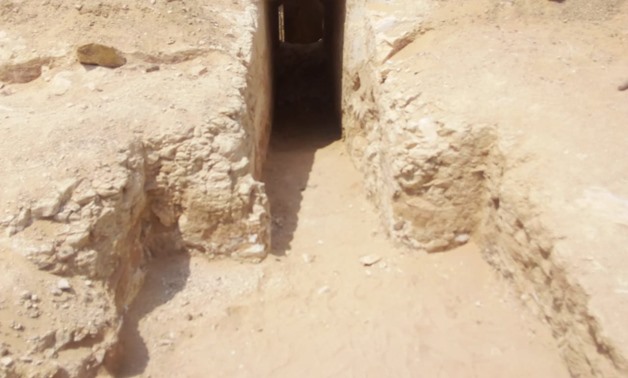
The Egyptian Archaeological Mission working at Lisht necropolis area, Giza, uncovered a rocky cemetery, located at the north east of Senusret I pyramid-Ministry of Antiquities'official Facebook Page
CAIRO – 5 September 2018: The Egyptian Archaeological Mission working at Lisht necropolis area, Giza, uncovered a rocky cemetery, located at the north east of Senusret I pyramid, according to a statement issued by the Ministry of Antiquities on Wednesday.
 The Egyptian Archaeological Mission working at Lisht necropolis area, Giza, uncovered a rocky cemetery, located at the north east of Senusret I pyramid-Ministry of Antiquities'official Facebook Page
The Egyptian Archaeological Mission working at Lisht necropolis area, Giza, uncovered a rocky cemetery, located at the north east of Senusret I pyramid-Ministry of Antiquities'official Facebook Page
The Head of the Central Administration for Cairo and Giza Antiquities, Adel Okasha, said that the excavation works carried out at Lisht area is part of the Ministry of Antiquities’ plan to excavate the promising archaeological sites.
 The Egyptian Archaeological Mission working at Lisht necropolis area, Giza, uncovered a rocky cemetery, located at the north east of Senusret I pyramid-Ministry of Antiquities'official Facebook Page
The Egyptian Archaeological Mission working at Lisht necropolis area, Giza, uncovered a rocky cemetery, located at the north east of Senusret I pyramid-Ministry of Antiquities'official Facebook Page
He referred that the cemetery consists of two parts; the first part, which is currently being restored, is an open courtyard that leads to a corridor with a ceiling full of hieroglyphic inscriptions and a hall with a small cabin decorated with traces of inscriptions.
At the same time, the second part contains a burial well in a courtyard found in front of the cemetery, and its southern side has an entrance leading to rooms, and more details about these rooms will be revealed in the upcoming period.
Director General of Antiquities in Dahshour and Lisht, Yasser Hassan Abdel Fatah, said that the owner’s name of the cemetery has not been revealed yet, and the mission will carry out more studies to find out.
The joint team of the Ministry of Antiquities and the University of Alabama in Birmingham (UAB), the United States, finished the documentation, mapping and 3D topographic survey at Lisht, according to the Ministry of Antiquities’ statement on Aug. 29.
The Head of the Central Administration for Cairo and Giza Antiquities Okasha said that 802 tombs from the Egyptian Middle Kingdom were documented.
He added that the archaeological survey is vital as it provides more information about the Middle Kingdom cemeteries including social hierarchy, religious rituals, and the daily life of Egypt’s capital ‘ItjTawy’ during the Middle Kingdom, known currently as Lisht.
Since 2012, the Ministry of Antiquities has been documenting Egypt’s cultural and archaeological sites using state-of-the-art equipment and modern technology to protect and preserve them as well as provide comprehensive detailed studies on every site, but it stopped after the January 25th revolution due to financial problems.
The documentation resumed in 2017 and started with Esna Temple and the Tanis site.
Most recently, the Ministry of Antiquities launched a project to document all the archaeological inscriptions across Egypt, particularly in Sinai’s valleys, Aswan, the Eastern and Western desert.



Comments
Leave a Comment